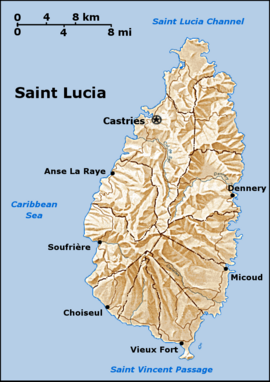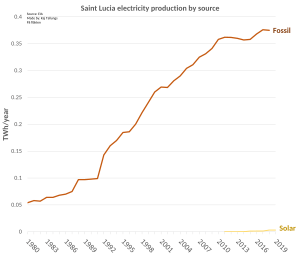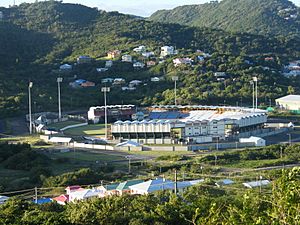Saint Lucia facts for kids
Quick facts for kids
Saint Lucia
Sent Lisi (Saint Lucian Creole French)
|
|
|---|---|
|
|
|
|
Motto: "The Land, The People, The Light"
|
|
|
Anthem: "Sons and Daughters of Saint Lucia"
|
|
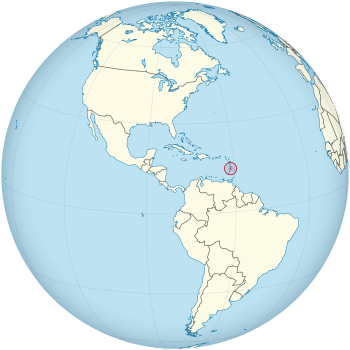
Location of Saint Lucia (circled in red)
in the Caribbean |
|
| Capital and largest city
|
Castries 13°53′00″N 60°58′00″W / 13.88333°N 60.96667°W |
| Official languages | English |
| Vernacular languages |
Saint Lucian Creole French |
| Ethnic groups
(2020)
|
|
| Religion
(2020)
|
|
| Demonym(s) | Saint Lucian |
| Government | Unitary parliamentary constitutional monarchy |
|
• Monarch
|
Charles III |
| Errol Charles (acting) | |
| Philip J. Pierre | |
| Legislature | Parliament |
| Senate | |
| House of Assembly | |
| Independence | |
|
• Associated State
|
1 March 1967 |
|
• Independence from the United Kingdom
|
22 February 1979 |
| Area | |
|
• Total
|
617 km2 (238 sq mi) (178th) |
|
• Water (%)
|
1.6 |
| Population | |
|
• 2018 estimate
|
|
|
• 2010 census
|
165,595 |
|
• Density
|
299.4/km2 (775.4/sq mi) (29th) |
| GDP (PPP) | 2023 estimate |
|
• Total
|
|
|
• Per capita
|
|
| GDP (nominal) | 2023 estimate |
|
• Total
|
|
|
• Per capita
|
|
| Gini (2016) | 51.2 high |
| HDI (2022) | high · 108th |
| Currency | East Caribbean dollar (XCD) |
| Time zone | UTC−4 (AST) |
| Driving side | left |
| Calling code | +1 758 |
| ISO 3166 code | LC |
| Internet TLD | .lc |
Saint Lucia is an island country of the West Indies in the eastern Caribbean. Part of the Windward Islands of the Lesser Antilles, it is located north/northeast of the island of Saint Vincent, northwest of Barbados and south of Martinique. It covers a land area of 617 km2 (238 square miles) with an estimated population of over 180,000 people as of 2018. The nation's capital and largest city is Castries.
The first proven inhabitants of the island, the Arawaks, are believed to have first to settle on the island in 200–400 AD. In 800 AD, the island would be taken over by the Kalinago. The French were the first European colonists to settle on the island, and they signed a treaty with the native Caribs in 1660. The English took control of the island in 1663. In ensuing years, England and France fought 14 times for control of the island; consequently control over this immensely valuable geopolitical position changed frequently. Eventually, the British took complete control in 1814, shortly after the victory over French Emperor Napoleon I. Because the island switched so often between British and French control, Saint Lucia was also known as the "Helen of the West" after the Greek mythological character, Helen of Troy.
Representative government was introduced in 1924 with universal suffrage being established in 1951. From 1958 to 1962, the island was a member of the West Indies Federation. On 22 February 1979, Saint Lucia became an independent state, while remaining as a Commonwealth realm.
Saint Lucia is a member of the United Nations, the Organization of American States, the World Trade Organization, CARICOM and the Organisation of Eastern Caribbean States (OECS). It is also a member of Organisation internationale de la Francophonie.
Etymology
Saint Lucia is named after Saint Lucy of Syracuse (AD 283 – 304). Saint Lucia is one of two sovereign states in the world named after a female and is the only one named after a woman (Ireland is named after a goddess). Legend states that French sailors were shipwrecked on the island on 13 December, the feast day of St. Lucy, and therefore named the island in her honour.
A globe in the Vatican from 1520 shows the island as Sancta Lucia, indicating that the island was instead named by early Spanish explorers. Saint Lucia was first known as Louanalao by the Arawak Indians in 200 AD, meaning “Island of the Iguanas,” and then as Hewanorra, in 800 AD, meaning "there where iguanas are found,” when the Carib Indians arrived and assimilated their culture into Saint Lucia.
History
Pre-Columbian
The first proven inhabitants of Saint Lucia were the Arawaks, though there may have been other native peoples prior to them. The Arawaks are believed to have come from northern South America, sometime around AD 200–400, as there are numerous archaeological sites on the island where specimens of their pottery have been found.
The Kalinago (Island Caribs) arrived around AD 800, and seized control from the Arawaks.
Early European exploration and colonization
It is possible that Christopher Columbus may have sighted the island during his fourth voyage in 1502, but he does not mention the island in his log. Juan de la Cosa noted the island on his map of 1500, calling it El Falcon, and another island to the south Las Agujas. A Spanish cédula from 1511 mentions the island within the Spanish domain, and a globe in the Vatican made in 1520, shows the island as Sancta Lucia.
In the late 1550s, the French pirate François le Clerc (known as Jambe de Bois, due to his wooden leg) set up a camp on Pigeon Island, from where he attacked passing Spanish ships. In 1605, an English vessel called the Oliphe Blossome was blown off-course on its way to Guyana, and the 67 colonists started a settlement on Saint Lucia, after initially being welcomed by the Carib chief Anthonie. By 26 September 1605, only 19 survived following continued attacks by the Carib chief Augraumart, so the settlers fled the island. The English tried to settle the island again in 1638, but the Caribs continued to be hostile. Eventually, the French successfully claimed the island in 1650 and they signed a treaty with the Caribs in 1660. In 1664, Thomas Warner (son of Sir Thomas Warner, the governor of St Kitts) claimed Saint Lucia for England but the English fled again in 1666, with the French gaining full control of the island after the signing of the Treaty of Breda. Saint Lucia was made an official French crown colony in 1674, as a dependency of Martinique.
18th and 19th centuries
After the slave-based sugar industry developed, both the British and the French found the island attractive. During the 18th century, the island changed ownership, or was declared neutral territory, a dozen times, although the French settlements remained and the island was a de facto French colony well into the eighteenth century.
In 1722, George I of Great Britain granted both Saint Lucia and Saint Vincent to the 2nd Duke of Montagu. Montague appointed Nathaniel Uring, a merchant sea captain and adventurer, as deputy-governor. Uring went to the islands with a group of seven ships, and established settlement at Petit Carenage. Unable to get enough support from British warships, he and the new colonists were quickly run off by the French.
During the Seven Years' War, Britain occupied Saint Lucia for a year, but handed the island back to the French in 1763, under the Treaty of Paris. Like the English and Dutch on other islands, in 1765, the French began to develop the land for the cultivation of sugar cane as a commodity crop on large plantations. The British occupied the island again in 1778.
From 1782 to 1803, control of the island switched multiple times. In January 1791, during the French Revolution, the National Assembly sent four commissaires to St Lucia to spread the revolutionary philosophy. By August 1791, slaves began to abandon their estates and Governor Jean-Joseph Sourbader de Gimat fled. In December 1792, Lt. Jean-Baptiste Raymond de Lacrosse arrived with revolutionary pamphlets, and the impoverished whites and free people of colour began to arm themselves as patriots. On 1 February 1793, France declared war on England and Holland, and General Nicolas Xavier de Ricard took over as Governor. The National Convention abolished enslavement on 4 February 1794. On 1 April 1794, St. Lucia was captured by a British expeditionary force led by Vice Admiral John Jervis. Morne Fortune was renamed Fort Charlotte. Soon, a combined force of French Revolutionary Army soldiers and maroons, L'Armee Française dans les Bois, began to fight back, starting the First Brigand War.
A short time later, the British invaded the island as a part of the war with France that had recently broken out. On 21 February 1795, French forces under the nominal control of Victor Hugues, defeated a battalion of British troops at Vieux Fort and Rabot. In 1796, Castries was burned as part of the conflict. Leading the 27th (Inniskilling) Regiment, General John Moore retook Fort Charlotte in 1796, after two days of bitter fighting. As an honour, the Fusiliers' regimental colour was displayed on the flagstaff of the captured fortress at Morne Fortune for an hour before being replaced by the Union Jack. Upon the capture of the fort, Moore's superior, Ralph Abercromby, departed the island and placed Moore in charge of the British garrison. Moore remained at this post until falling ill with yellow fever, leading to his return to Britain before 1798.
In 1803, the British regained control of the island. Many members of the L'Armee Française dans les Bois escaped into the thick rainforest where they evaded capture and established maroon communities.
Slavery on the island continued for a short time, but anti-slavery sentiment was rising in Britain. The British stopped the import of slaves by anyone, white or coloured, when they abolished the slave trade in 1807.
France and Great Britain continued to contest Saint Lucia until the British secured it in 1814, as part of the Treaty of Paris, ending the Napoleonic Wars. Thereafter, Saint Lucia was considered one of the British Windward Islands colonies.
The institution of slavery was abolished on the island in 1834, as it was throughout the British Empire. After abolition, all former slaves had to serve a four-year "apprenticeship", to accustom them to the idea of freedom. During that period, they worked for their former masters for at least three-quarters of the work week. Full freedom was duly granted by the British in 1838. By that time, people of African ethnicity greatly outnumbered those of ethnic European background. People of Carib descent also comprised a minority on the island.
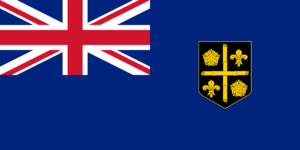
20th century
Saint Lucia's first representative government was introduced in 1924, with the first election taking place in 1925. Many Saint Lucians served during the Second World War, and the conflict visited the island directly during the Battle of the Caribbean, when a German U-boat attacked and sank two British ships in Castries harbour on 9 March 1942. The United States used the island as a military hub during the war, including setting up a secondary naval base in Gros Islet and using what is now the island's international airport as an air force base.
Universal suffrage was introduced in 1951 and elections were held the same year. In 1958, Saint Lucia joined the West Indies Federation, although the federation was dissolved just years later in 1962. In 1967, Saint Lucia became one of the six members of the West Indies Associated States, with internal self-government. Independence was peacefully gained in 1979 under Sir John Compton of United Workers Party, with the island remaining within the British Commonwealth, keeping then-Queen Elizabeth II as Monarch, represented locally by a Governor-General.
Post-independence era
In 1980, Hurricane Allen struck the island, destroying much of its infrastructure and reducing economic growth. During the 1990s and 2000s, the nation's economy began shifting from agriculture to tourism under the leadership of Kenny Anthony.
Geography
Saint Lucia has a total area of 617 square kilometers (238 sq mi). As a volcanic island, Saint Lucia is very mountainous, with its highest point being Mount Gimie, at 950 metres (3,120 feet) above sea level. The Pitons, two mountainous volcanic plugs, form the island's most famous landmark. Saint Lucia is also home to the world's only drive-in volcano, the Sulphur Springs. There are a number of small islands off the coast, the largest of which are the Maria Islands, located in the south-east of the island.
Saint Lucia lies at latitude 14° N and longitude 61° W. The population tends to be concentrated around the coast, with the interior more sparsely populated, due to the presence of dense forests. Many species are endemic to the island, including the Anolis luciae, a species of lizard, and the Boa orophias, a species of boid snake.
Saint Lucia has five terrestrial ecoregions: Windward Islands moist forests, Leeward Islands dry forests, Windward Islands dry forests, Windward Islands xeric scrub, and Lesser Antilles mangroves. The country had a 2019 Forest Landscape Integrity Index mean score of 6.17/10, ranking it 84th globally out of 172 countries.
Climate
Saint Lucia has a tropical climate, specifically a tropical rainforest climate (Af), moderated by northeast trade winds, with a dry season from 1 December to 31 May, and a wet/rainy season from 1 June to 30 November.
Average daytime and nighttime temperatures are around 30 °C (86.0 °F), and 24 °C (75.2 °F) respectively. Being fairly close to the equator, the island's temperature does not fluctuate much between winter and summer.
| Climate data for St Lucia | |||||||||||||
|---|---|---|---|---|---|---|---|---|---|---|---|---|---|
| Month | Jan | Feb | Mar | Apr | May | Jun | Jul | Aug | Sep | Oct | Nov | Dec | Year |
| Mean daily maximum °C (°F) | 29 (84) |
29 (84) |
29 (84) |
30 (86) |
31 (88) |
31 (88) |
31 (88) |
31 (88) |
31 (88) |
31 (88) |
30 (86) |
29 (84) |
30 (86) |
| Daily mean °C (°F) | 26 (79) |
26 (79) |
26 (79) |
27 (81) |
28 (82) |
28 (82) |
28 (82) |
28 (82) |
28 (82) |
28 (82) |
27 (81) |
26 (79) |
27 (81) |
| Mean daily minimum °C (°F) | 23 (73) |
23 (73) |
24 (75) |
24 (75) |
25 (77) |
25 (77) |
25 (77) |
25 (77) |
25 (77) |
25 (77) |
24 (75) |
24 (75) |
24 (76) |
| Average precipitation mm (inches) | 125 (4.9) |
95 (3.7) |
75 (3.0) |
90 (3.5) |
125 (4.9) |
200 (7.9) |
245 (9.6) |
205 (8.1) |
225 (8.9) |
260 (10.2) |
215 (8.5) |
160 (6.3) |
2,020 (79.5) |
| Average precipitation days | 14 | 9 | 10 | 10 | 11 | 15 | 18 | 16 | 17 | 20 | 18 | 16 | 174 |
| Mean monthly sunshine hours | 248 | 226 | 248 | 240 | 248 | 240 | 248 | 248 | 240 | 217 | 240 | 248 | 2,891 |
| Source: climatestotravel | |||||||||||||
Geology
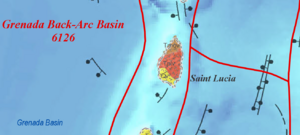
The geology of St. Lucia can be described as composing three main areas. The oldest, 16–18 Ma, volcanic rocks are exposed from Castries northward and consist of eroded basalt and andesite centres. The middle, central highlands, portion of the island consists of dissected andesite centres, 10.4 to 1 Mya, while the lower southwest portion of the island contains recent activity from the Soufriere Volcanic Centre (SVC). This SVC, centred about the Qualibou depression, contains pyroclastic flow deposits, lava flows, domes, block and ash flow deposits, and explosion craters. This depression's perimeter includes the town of Soufriere, Mount Tabac, Mt. Gimie, Morne Bonin, and Gros Piton. At 10 kilometres (6.2 mi) in diameter, though the western portion is open towards the Grenada basin, the depression formed as recently as 100 kya. The depression is noted for its geothermal activity, especially at Sulphur Springs and Soufrière Estates, a phreatic eruption in 1776, and recent seismic activity (2000–2001).
Eroded andesitic stratovolcanoes to the north east of the depression include Mt. Gimie, Piton St Esprit, and Mt. Grand Magazin, all greater than 1 Ma in age. Andesitic and dacite pyroclastic flows from these volcanoes are found at Morne Tabac dome (532 ka), Morne Bonin dome (273 kya), and Bellevue (264 kya). Avalanche deposits from the formation of the Qualibou depression are found offshore, and in the massive blocks of Rabot, Pleisance, and Coubaril. The dacitic domes of Petit Piton (109 kya) and Gros Piton (71 kya) were then extruded onto the depression floor accompanied by the Anse John (104 kya) and La Pointe (59.8 kya) pyroclastic flows. Later, pyroclastic flows include pumice-rich Belfond and Anse Noir (20 kya). Finally, the dacitic domes of Terre Blanche (15.3 kya) and Belfond (13.6 kya) formed within the depression.
Government
Like most Caribbean countries, Saint Lucia is a unitary state with a parliamentary system. It is a Commonwealth realm and a constitutional monarchy, with the current monarch being Charles III, who is represented on the island by a governor-general. The prime minister is the head of government, the head of the cabinet, and is normally the leader of the largest party in the House of Assembly. The house has 17 seats, with each member being elected via a plurality of votes in their constituency. The upper chamber of Parliament is the Senate which has 11 appointed members, the majority of which are appointed by the prime minister.
Administrative divisions
Saint Lucia is made up of 10 districts. The districts were created and named by French colonials, and the British chose to keep the names in an anglicised form. The largest district in both size and population is Castries, where the nation's capital of the same name is located. The following are the 10 districts placed in alphabetical order:
Foreign relations
Saint Lucia is a member of the Caribbean Community, OECS, the Organization of American States and La Francophonie. As a Commonwealth Realm, Saint Lucia has relatively friendly relations with United Kingdom and Canada. France is also a major ally, in part due to Saint Lucia's border with Martinique. The United States is the island's largest trading partner, and Saint Lucia was key to the US invasion of Grenada in 1983, and voted against condemning the invasion. Saint Lucia became the 152nd member of the United Nations on 18 September 1979.
Saint Lucia does not have a military although the Royal Saint Lucia Police Force has a Special Service Unit (SSU) and a Coast Guard. The island signed the UN Treaty on the Prohibition of Nuclear Weapons in 2018.
Economy
Saint Lucia is a Small Island Developing State, a designation similar to a developing country with a few substantial differences due to Saint Lucia's island nature. The service sector is the largest sector of the economy, accounting for 86.9% of GDP in 2020, followed by industrial and agricultural sectors at 10.9% and 2.2%, respectively.
Saint Lucia has been able to attract foreign business and investment due to its educated workforce and improvements in roads, communications, water supply, sewerage, and port facilities. Like most small islands, Tourism and offshore banking are Saint Lucia's main sources of revenue. Agriculture, specifically the banana industry, was previously the largest sector of the economy, although its importance has declined significantly. The island's manufacturing sector has been called the most diverse in the Eastern Caribbean, with goods such as plastic being produced on a large scale.
Saint Lucia's currency is the Eastern Caribbean Dollar (EC$), a regional currency shared among members of the Eastern Caribbean Currency Union (ECU). The country's main trade partners are the US, UK, EU and other CARICOM countries.
Tourism
Tourism is the largest contributor to Saint Lucia's economy. Tourist numbers tend to be more substantial during the dry season (January to April), often referred to as the tourist season. Saint Lucia's tropical weather, scenery, beaches and resorts have made it a popular tourist destination, with 1.29 million visitors arriving in 2019.
Some of Saint Lucia's tourist attractions include the Sulphur Springs, the Botanical Gardens, Pigeon Island and The Pitons.
Agriculture
The agricultural sector was once the main contributor to Saint Lucia's economy. This was especially thanks to the exporting of bananas. However, its importance to the economy has declined significantly, in part due to increased competition from South American countries in the banana industry. Nevertheless, agriculture is still an important part of the country's economy, providing 7.9% of jobs and contributing to 2.2% of the GDP in 2021.
About 18% of land is used for agricultural practices. Bananas remain the main agricultural product grown in Saint Lucia, as well as coconuts, cocoa beans, mangoes, avocados, vegetables, citrus fruits, and root crops such as yams and sweet potatoes.
Saint Lucia also has a small livestock sector, which is dominated by poultry. The island is self-sufficient in egg production and production of poultry and pork has increased in recent years. Fishing has also been of considerable importance to the nation's economy.
Infrastructure
Saint Lucia has a wide-ranging public bus network which covers most of the island. Busses are owned by private individuals, whilst the government is responsible for setting up routes and hubs. The road network covers most of the island, although some rural areas still lack access to proper roads.
The island has two airports, including one International airport. Cruising and yachting are very important to the country's economy, with the main sea port being located in Castries, while the main marina is located in Rodney Bay. Meanwhile, the nation's main oil refinery is located in Bexon.
The main source of electricity in Saint Lucia is oil through its sole power station, the Cul De Sac Power Station, although solar energy is also a major source. There have also been attempts to introduce geothermal and wind energy to the island.
Demographics
A census is normally held in Saint Lucia every 10 years. In the 2010 census, Saint Lucia reported a population of 165,595 in 58,920 households. This was a 5.1% increase from the 157,490 recorded at the previous census in 2001. Ages 0–14 made up 24.1% of the population whilst those 65 and over made up 8.6%. Nearly 40% of the island's population lived in the District of Castries, where the nation's capital of the same name is located.
Saint Lucia had a fertility rate of 1.4 children per woman in 2021, the lowest in the Americas. This is much lower than in 1990, when the birth rate was 3.4 children per woman, and significantly lower than in 1959, when the birth rate peaked at 6.98 children per woman. Most emigration from Saint Lucia is primarily to Anglophone countries, with the United Kingdom having almost 10,000 Saint Lucian-born citizens, and over 30,000 of Saint Lucian heritage. The United States is home to many Saint Lucians, especially areas such as Miami and New York City. Canada is also home to many Saint Lucians, and especially in the French-speaking province of Quebec in the city of Montréal. The median age of Saint Lucians was 33.1 years in 2021.
Ethnic groups
Saint Lucia was originally populated by Amerindian peoples. However, European colonisation led to a significant drop in the indigenous populations. Most residents of the island were white planters, but African slaves and indentured servants brought by the Europeans eventually came to outnumber them. Because of this, Saint Lucia's population is predominantly of African and mixed descent. As of 2010, 85.3% of the population are black and 10.9% are of multiracial descent. Other groups include Indo-Caribbean persons (2.2%), whites (0.6%), and Indigenous Persons (0.6%). A small number of Kalinago live in the Choiseul region and in other towns on the western coast. There is also a small population of Lebanese and Syrians.
Languages
The official language of Saint Lucia is English, though Saint Lucian French Creole (Kwéyòl) is widely spoken. Referred to colloquially as Patois ("Patwa"), it is spoken by a majority of the population. It is a dialect of Antillean Creole and is also related to Haitian Creole, though it nonetheless has a number of distinctive features from the latter. The Creole language developed during the early period of French colonisation and is derived chiefly from French and West African languages. There have been some attempts to make the language official, but they have not yet been successful.
Religion
Religion in Saint Lucia (2010 census) Christianity (90.3%) Irreligion (5.9%) Rastafari (1.9%) Hinduism (1.4%) Other Religions (0.5%) Not Stated (1.4%)
In the 2010 census, a majority of Saint Lucians identified as Christians. This can be traced back to the nation's colonization by French and British settlers. Due to heavy French influence, most Christians on the island are Catholics, with 62.5% of the island's residents identifying as such. 24.5% of the island's residents identify as Protestants. In addition, 1.9% of the population identified as members of the Rastafari movement and 1.4% of the population practice Hinduism. The number of residents claiming no religion stood at 5.9% in 2010.
There is no state religion in Saint Lucia. The nation's constitution guarantees freedom of religion and prohibits forcing persons to take oath to any religion in which they do not follow. Religious groups are also guaranteed the freedom to establish places of education.
Education
Most primary and secondary schools in Saint Lucia are operated by the government. Education is free and compulsory for children aged five to fifteen. This includes seven years of primary school and three to five years of secondary school. In the last two years of secondary school, students are allowed to choose the subjects that they would like to do, in preparation for regional CSEC examinations. In 2020, public spending on education was at 3.6%.
Tertiary educational facilities on the island are normally private institutions. These include Monroe College and International American University. However, there are still a few public institutions, including the Sir Arthur Lewis Community College and the University of the West Indies.
Healthcare
Health services in Saint Lucia are split between the government and private institutions. The island is served by 2 public hospitals and multiple health centers, although most dental and vision services are private. Public expenditure on healthcare stood at 2.1% in 2019.
In 2021, life expectancy was at 71.1 years (67.8 for men and 74.7 for women). This was compared to 73.4 years in 2019. The drop in life expectancy was largely attributed to the COVID-19 pandemic.
Culture
The culture of Saint Lucia has been influenced by African, East Indian, French, and English heritage. The main secondary language of the island is Saint Lucian Creole (Kwéyòl), a French-based creole spoken by most of the population. The island boasts the highest ratio of Nobel laureates produced with respect to the total population of any sovereign country in the world. Two winners have come from Saint Lucia: Sir Arthur Lewis, who won the Nobel Prize in Economics in 1979, and the poet Derek Walcott, who received the Nobel Prize in Literature in 1992. Saint Lucia has two flower festivals, the La Rose festival, celebrated on 30 August, and the La Marguerite festival, celebrated on 17 October. Every summer, the island hosts a carnival as a way to present the country's culture and music. Annually, there are normally many festivals, most of them being music related.
Music
Saint Lucian music is heavily influenced by elements of African music, especially rhythmically. The most popular music genres in Saint Lucia are calypso, soca, dancehall, reggae, zouk, and folk music. Dennery Segment, a genre influenced by Angolan Kuduro, Saint Lucian Solo music and Dancehall was developed on the island. The internationally renowned Saint Lucia Jazz Festival is held annually, and the festival is a major source of revenue for the country's economy.
Food
Saint Lucian cuisine is a mix of African, European, Indian and Caribbean dishes. Some common dishes include macaroni pie, stewed chicken, rice and peas, roti (Indian flatbreads) and soups packed full with fresh locally produced vegetables. All mainstream meat and poultry are eaten in St. Lucia; meat and seafood are normally stewed and browned to create a rich gravy sometimes served over "ground provisions" (vegetables) or rice. Johnny Cakes (known as bakes) are also common, and are served with different sides, such as saltfish. The national dish of Saint Lucia is green figs and saltfish.
Sports
Like most Caribbean islands, cricket is the most popular sport in Saint Lucia. The Windward Islands cricket team includes players from Saint Lucia and plays in the West Indies regional tournament. Daren Sammy became the first Saint Lucian to represent the West Indies on his debut in 2007, and was made captain in 2010. The Saint Lucia Kings is a T20 franchise playing in the Caribbean Premier League based in this said island nation. Sailing is also a major sport in Saint Lucia, with the Atlantic Rally for Cruisers (ARC) race beginning in the Canary Islands and ending on the island. Other sports that are popular on the island include football, basketball, tennis, golf and volleyball. Karate and boxing have also seen increased popularity in recent years.
Julien Alfred won the nation's first-ever Olympic medal, when she won the women's 100 meters event in 10.72 seconds at the 2024 Summer Olympics held in Paris, France.
See also
 In Spanish: Santa Lucía para niños
In Spanish: Santa Lucía para niños
- British African-Caribbean people
- Chief Justice of the Leeward Islands
- Index of Saint Lucia-related articles
- List of Caribbean islands
- List of colonial governors and administrators of Saint Lucia
- List of Saint Lucians
- Outline of Saint Lucia
- West Indies Federation




